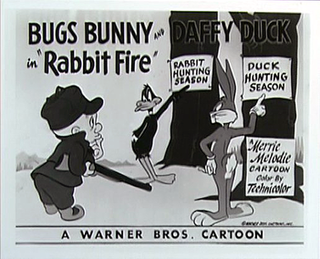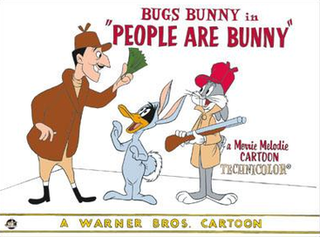Related Research Articles

Melvin Jerome Blanc was an American voice actor and radio personality whose career spanned over 60 years. During the Golden Age of Radio, he provided character voices and vocal sound effects for comedy radio programs, including those of Jack Benny, Abbott and Costello, Burns and Allen, The Great Gildersleeve, Judy Canova, and his own short-lived sitcom.

Bugs Bunny is an animated cartoon character created in the late 1930s at Warner Bros. Cartoons and voiced originally by Mel Blanc. Bugs is best known for his featured roles in the Looney Tunes and Merrie Melodies series of animated short films, produced by Warner Bros. Earlier iterations of the character first appeared in Ben Hardaway's Porky's Hare Hunt (1938) and subsequent shorts before Bugs's definitive characterization debuted in Tex Avery's A Wild Hare (1940). Bob Givens, Chuck Jones and Robert McKimson are credited for defining Bugs's design.

Daffy Duck is an animated cartoon character created for Leon Schlesinger Productions by animators Tex Avery and Bob Clampett. Styled as an anthropomorphic black duck, he has appeared in cartoon series such as Looney Tunes and Merrie Melodies, in which he is usually depicted as a foil for either Bugs Bunny or Porky Pig. He was one of the first of the new "screwball" characters that emerged in the late 1930s to replace traditional everyman characters who were more popular earlier in the decade, such as Mickey Mouse, Porky Pig, and Popeye.

Porky Pig is an animated character in the Warner Bros. Looney Tunes and Merrie Melodies series of cartoons. He was the first character created by the studio to draw audiences based on his star power, and the animators created many critically acclaimed shorts featuring the character. Even after he was supplanted by later characters, Porky continued to be popular with moviegoers and, more importantly, the Warners directors, who recast him in numerous everyman and sidekick roles.

Tweety is a yellow canary in the Warner Bros. Looney Tunes and Merrie Melodies series of animated cartoons. The name "Tweety" is a play on words, as it originally meant "sweetie", along with "tweet" being an English onomatopoeia for the sounds of birds. His characteristics are based on Red Skelton's famous "Junior the Mean Widdle Kid." He appeared in 46 cartoons during the golden age, made between 1942 and 1964.

Sylvester J. Pussycat, Sr. is a fictional character, an anthropomorphic cat in the Looney Tunes and Merrie Melodies series of cartoons. Most of his appearances have him often chasing Tweety Bird, Speedy Gonzales, or Hippety Hopper. He appeared in 103 cartoons in the golden age of American animation, lagging only behind superstars Bugs Bunny, Porky Pig, and Daffy Duck. Three of his cartoons won Academy Awards, the most for any starring a Looney Tunes character: they are Tweetie Pie, Speedy Gonzales, and Birds Anonymous.

Leon Schlesinger was an American film producer who founded Leon Schlesinger Productions, which later became the Warner Bros. Cartoons studio, during the Golden Age of American animation. He was a distant relative of the Warner Brothers. As head of his own studio, Schlesinger served as the producer of Warner's Looney Tunes and Merrie Melodies cartoons from 1930, when Schlesinger assumed production from his subcontractors, Harman and Ising, to 1944, when Warner acquired the studio.

Yosemite Sam is a cartoon character in the Looney Tunes and Merrie Melodies series of short films produced by Warner Bros. His name is taken from Yosemite National Park. He is an adversary of Bugs Bunny. He is commonly depicted as a mean-spirited and extremely aggressive, gunslinging outlaw or cowboy with a hair-trigger temper and an intense hatred of rabbits, Bugs in particular. In cartoons with non-Western themes, he uses various aliases, including "Chilkoot Sam" and "Square-deal Sam" in 14 Carrot Rabbit, "Riff Raff Sam" in Sahara Hare, "Sam Schultz" in Big House Bunny, "Seagoin' Sam" in Buccaneer Bunny, "Shanghai Sam" in Mutiny on the Bunny, "Von Schamm the Hessian" in Bunker Hill Bunny, "Baron Sam von Schpamm" in Dumb Patrol, and many others. During the golden age of American animation, Yosemite Sam appeared in 33 shorts made between 1945 and 1964.

William Richard Werstine, known professionally as Billy West, is an American voice actor. His voice roles include Bugs Bunny in the 1996 film Space Jam and several subsequent projects, the title characters of Doug and The Ren & Stimpy Show, as well as the Futurama characters Philip J. Fry, Professor Farnsworth, Dr. Zoidberg, and Zapp Brannigan. In commercials, he voices the Red M&M and formerly voiced Buzz for Honey Nut Cheerios. West also voices other such established characters such as Bugs Bunny, Elmer Fudd, Popeye, Shaggy Rogers, Skeets, Muttley, and Woody Woodpecker. He was a cast member on The Howard Stern Show, during which time he was noted for his impressions of Larry Fine, Marge Schott, George Takei, and Jackie Martling.

Solomon Hersh "Paul" Frees was an American actor, comedian, impressionist, and vaudevillian. He is known for his work on Metro-Goldwyn-Mayer, Walter Lantz, Rankin/Bass and Walt Disney theatrical cartoons during the Golden Age of Animation, and for providing the voice of Boris Badenov in The Rocky and Bullwinkle Show. Voice actor Mel Blanc said Frees was known as "The Man of a Thousand Voices", though the appellation was more commonly bestowed on Blanc himself.

Michigan J. Frog is an animated cartoon character from the Warner Bros.' Merrie Melodies film series. Originally a one-shot character, his only appearance during the original run of the Merrie Melodies series was as the star of One Froggy Evening, written by Michael Maltese and directed by Chuck Jones. In this cartoon, partly inspired by a 1944 Cary Grant film entitled Once Upon a Time, Michigan is a male frog who wears a top hat; carries a cane; and sings pop music, ragtime, Tin Pan Alley hits, and other songs from the late 19th and early 20th centuries while dancing and performing acrobatics in the style of early 20th century vaudeville. Michigan is discovered by a hapless construction worker who plans to profit off his talents but catches on too late that the frog will perform only for his owner alone. In front of anyone else, Michigan is an ordinary croaking frog, and when he does perform, he finishes each song before the man can showcase his talent, thus thwarting his dreams of wealth.

Rabbit Fire is a 1951 Looney Tunes cartoon starring Bugs Bunny, Daffy Duck, and Elmer Fudd. Directed by Chuck Jones and written by Michael Maltese, the cartoon is the first in Jones' "hunting trilogy"—the other two cartoons following it being Rabbit Seasoning and Duck! Rabbit, Duck! It is also the first cartoon to feature a feud between Bugs and Daffy. Produced by Edward Selzer for Warner Bros. Cartoons, Inc., the short was released to theaters on May 19, 1951 by Warner Bros. Pictures and is often considered among Jones' best and most important films.

Pepé Le Pew is an animated character from the Warner Bros. Looney Tunes and Merrie Melodies series of cartoons, introduced in 1945. Depicted as a French striped skunk, Pepé is constantly on the quest for love. However, his offensive skunk odor and his aggressive pursuit of romance typically cause other characters to run away from him.
Robert Cameron Bruce Jr. was an American voice actor and the son of Robert Cameron Bruce (1887–1948) who was a cinematographer and documentary producer. He was the narrator for a number of Warner Bros. cartoons in the 1930s and 1940s. The Looney Tunes and Merrie Melodies series' had occasional entries which were driven not by one of their stable of stars such as Bugs Bunny or Daffy Duck, but by individual short sketches, usually filled with sight gags and word-play. Later he was a writer and producer of industrial motion pictures based in Minnesota.

People Are Bunny is a 1959 Warner Bros. Merrie Melodies cartoon, directed by Robert McKimson The short was released on December 19, 1959, and stars Bugs Bunny and Daffy Duck.

Bugs & Daffy: The Wartime Cartoons is a 1989 direct-to-video program by MGM/UA Home Video, containing 11 Looney Tunes and Merrie Melodies shorts, all of which are centered on World War II. Film critic Leonard Maltin tells trivia and facts about each animated short.

Foghorn Leghorn is a cartoon rooster who appears in Looney Tunes and Merrie Melodies cartoons and films from Warner Bros. Animation. He was created by Robert McKimson, and starred in 29 cartoons from 1946 to 1964 in the golden age of American animation. All 29 of these cartoons were directed by McKimson.

Elmer J. Fudd is an animated cartoon character in the Warner Bros. Looney Tunes/Merrie Melodies series and the archenemy of Bugs Bunny. He has one of the more disputed origins in the Warner Bros. cartoon pantheon. His aim is to hunt Bugs, but he usually ends up seriously injuring himself and other antagonizing characters. He speaks in an unusual way, replacing his Rs and Ls with Ws, so he often refers to Bugs Bunny as a "scwewy" or "wascawwy (rascally) wabbit". Elmer's signature catchphrase is, "Shhh. Be vewy vewy quiet, I'm hunting wabbits", as well as his trademark laughter.

Charles Daniel Hanks Jr., better known as Chuck Riley, was an American voice actor. He was famous for recording hundreds of movie trailers, television commercials, network promotions, and children's audiobooks. In his earlier years as a radio DJ, he was known as Chuck Dann and Charlie Tuna.
Noel Barton Blanc is an American commercial producer and retired voice actor. He is the son of the late cartoon voice actor Mel Blanc.
References
- ↑ http://www.clevelandschoolreunion.net/Class%20of%201962.html Archived 2009-02-20 at the Wayback Machine Cleveland H.S. Class of 1962 -- Class Photos page.
- ↑ The Dayton Daily News, July 29, 1967
- ↑ http://www.daytondailynews.com/news/dayton-news/dale-huffman-former-wing-disc-jockey-made-a-name-for-himself--320091.html "Former WING Disk Jockey Made a Name for Himself"
- ↑ The Hollywood Reporter, section R5, November 29, 1972